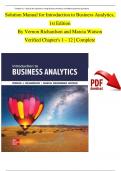Exam (elaborations)
Solution Manual for Introduction to Business Analytics, 1st Edition By Vernon Richardson and Marcia Watson, Verified Chapters 1 - 12, Complete Newest Version
- Course
- Institution
Solution Manual for Introduction to Business Analytics, 1st Edition By Vernon Richardson and Marcia Watson, Verified Chapters 1 - 12, Complete Newest Version Solution Manual for Introduction to Business Analytics, 1st Edition By Vernon Richardson and Marcia Watson Solution Manual for Introduc...
[Show more]



